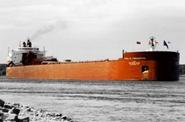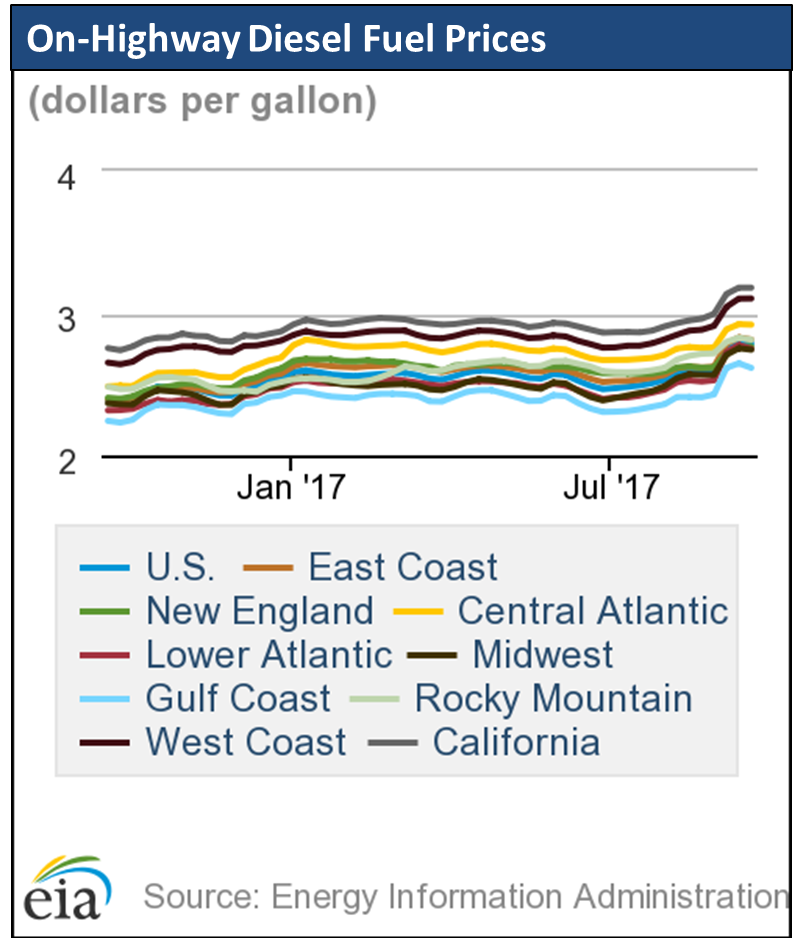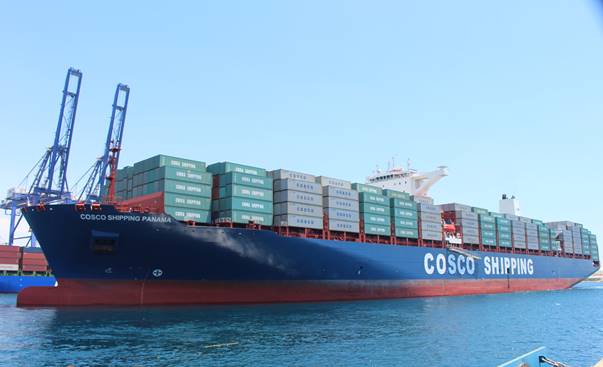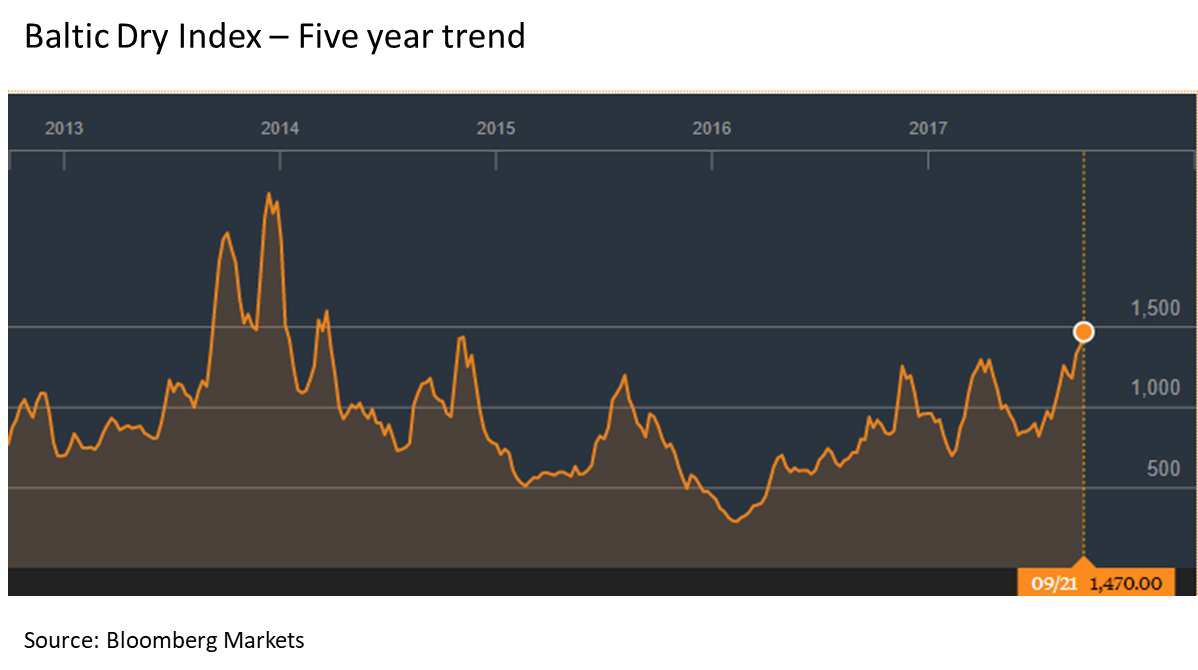Shipping and Logistics

September Shipping Report
Written by Sandy Williams
September 24, 2017
Seaborne shipping is getting a much needed rise in rates. Freight rates are gaining strength following two years of historic lows, says MID-SHIP report. The Baltic Dry index, a benchmark for overall trade volume, rose to 1470 on Sept. 21 for its highest level in two years. MID-SHIP expects the BDI to approach 2000 in November, boosted by an increase in capesize rates, vessels carrying dry bulk materials.
The Capesize Market has benefited from increased activity in the coal and iron trades as China steel production supported shipments of steelmaking raw materials. With China at a production peak, seasonal slowdown looming and further government cuts on the horizon, demand is expected to falter.
River
Barges on America’s waterways are experiencing delays on the Illinois and Ohio Rivers. Three vessels that ran aground last week on the Illinois 77 miles above the Mississippi required the Army Corps of Engineers to dredge a section of the river. In addition, delays are reported at Ohio River lock 52. Queues of barges at both the Illinois and Ohio locations are experiencing delays of 2-3 days. Expect a number of closures at the Peoria lock on the Illinois between Oct. 15 and Oct. 27. A low water advisory is in effect on the Lower Mississippi near Memphis restricting drafts to 11 feet or lower.
Trucking
Truck capacity remains tight in the U.S. MID-SHIP reports higher rates in New Orleans and Mobile due to truck shortages. Carriers continue to struggle with recruiting and retaining drivers.
 DAT reports load-to-truck ratios are high with shifting of freight going into Florida from Atlanta and Charlotte. Spot rates have also soared as more shipments go into the area than out. Early relief efforts are delivered in vans or reefers, but once rebuilding starts flatbeds will begin bringing construction materials. Flatbed rates rose in the Southeast as shippers moved freight out ahead of the storms. As the Southeast begins rebuilding in earnest, capacity could tighten further for flatbed users around the nation.
DAT reports load-to-truck ratios are high with shifting of freight going into Florida from Atlanta and Charlotte. Spot rates have also soared as more shipments go into the area than out. Early relief efforts are delivered in vans or reefers, but once rebuilding starts flatbeds will begin bringing construction materials. Flatbed rates rose in the Southeast as shippers moved freight out ahead of the storms. As the Southeast begins rebuilding in earnest, capacity could tighten further for flatbed users around the nation.
National flatbed load posts increased 41 percent the week of Sept. 10-16 pushing the load-to-truck ratio to 41.1 loads per truck for the highest ratio since April. A monthly comparison of flatbed load posts shows a decline of 5 percent in August, while truck posts increased 22 percent. As a result, the load-to-truck ratio for August fell 22 percent to 28.7 loads per truck, but was 170 percent higher than August 2016. Flatbed rates stayed steady at $2.24 per mile during the period, but were at the highest average in more than two years, according to DAT.
Diesel fuel averaged $2.78 per gallon nationally as of Sept. 18.
Rail
Total U.S. rail traffic for the week ending Sept. 16 was 530,774 carloads and intermodal units, down 1.4 percent compared with the same week last year, reports the Association of American Railroads. Carload declined 3.6 percent y/y to 260,771 carloads, while intermodal volume increased 0.9 percent to 270,003 containers.
Great Lakes
A renewed push to obtain funding for expansion of the Soo Locks is underway. Of the four locks at the complex, only the MacArthur and Poe Locks are operational. The giant lake vessels that carry iron ore and coal to steelmakers on the North Coast must use the 50-year-old Poe Lock for transit. More than 80 million tons of commodities pass through the Soo Locks each year, and a 2015 Homeland Security study says an unscheduled six-month closure of the Poe would be catastrophic to the supply chain, jobs and GDP. Such a shutdown would result in a $1.1 trillion loss in gross domestic product and put the economy into a severe recession.
Congress authorized the building of a new Poe-sized lock in 1986, but funding was never provided. New legislation was introduced in June to seek funding and last week the Great Lakes Commission signaled its support in a letter to Congress. The U.S. Army Corps of Engineers estimates a new lock could cost about $1 billion.
“It’s critical to the security of our state, regional, and national economies that we build a new Poe-sized lock at the Soo Locks,” said U.S. Rep. Rick Nolan (D-MN-8), a longtime advocate for the Soo Locks and a co-sponsor of the legislation. He noted that “the Department of Homeland Security has correctly described the Soo Locks as the ‘the Achilles heel of the North American industrial economy.'”

Sandy Williams
Read more from Sandy WilliamsLatest in Shipping and Logistics

Reibus logistics update: Inflation makes a comeback
As we navigate through the first half of 2024, we are seeing early signs of an inflationary rate environment for flatbed shipping, albeit slightly later than anticipated. Excess supply has persisted longer than expected for both flatbed and dry van, resulting in rates remaining lower than for longer than anticipated.

SMU Community Chat: Posner talks state of global logistics
While shipping and supply chains have always been subject to wars, pirates, privateers, geopolitical issues, and natural disasters, it seems that “it’s been busier lately when it comes to dealing with significant supply chain disruptions,” according to logistics expert Anton Posner.

CRU: Baltimore bridge collapse affects more than half of US thermal coal exports
A container ship collided with the Francis Scott Key Bridge in Baltimore on March 26, causing it to collapse. This has blocked sea lanes into and out of Baltimore port, which is the largest source of US seaborne thermal coal exports. The port usually exports 1–1.5 million metric tons (mt) of thermal coal per month. It is uncertain when sea shipping will be restored. But it could be several weeks or more. There are coal export terminals in Virginia, though diversion to these ports would raise costs.

USW reaches tentative pact with CN Rail
United Steelworkers (USW) union members in Canada have reached a tentative labor agreement with CN Rail.

SMU Community Chat: Feb. 21 with Anton Posner, CEO of Mercury Resources
Mercury Resources CEO Anton Posner will be the featured speaker on SMU’s next Community Chat webinar on Wednesday, Feb. 21, at 11 am ET. The live webinar is free for all. A recording of the webinar and the slide deck are free for SMU members.


